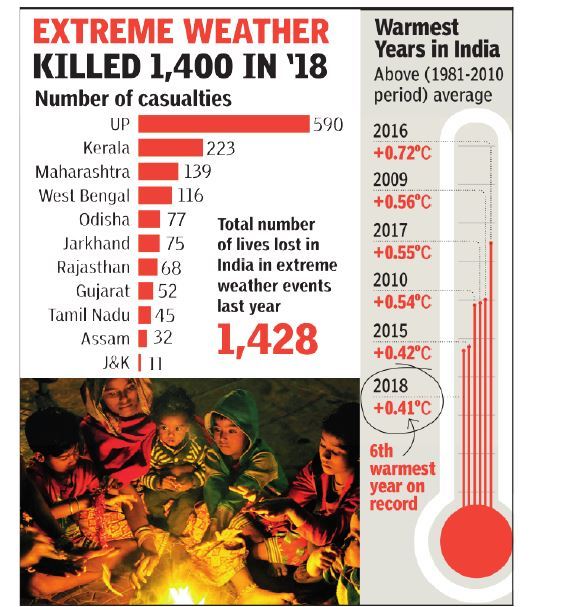What is the issue?
- A recently released IMD (India Meteorological Department) statement shows 2018 as the sixth warmest year on record.
- In this context, a look at the temperature and rainfall trends last year and a series of extreme weather events becomes essential.
How was 2018 overall?
- 2018 was the sixth warmest year on record, with the average temperature over India being “significantly above normal”.
- [The 5 warmest years on record (nationwide records began in 1901) are, in order, 2016, 2009, 2017, 2010, 2015.
- Notably, 11 of the 15 warmest years were during the recent past fifteen years (2004-18).
- The 20 warmest years on record have been in the past 22 years, with the top four in the past four years.
How was the temperature trend?
- The temperature trends of recent years are part of the larger “global warming” trend.
- The rate of increase of temperatures over India is almost similar to the global average.
- The winter and pre-monsoon seasons, with an anomaly of +0.590°C and +0.550°C respectively, mainly contributed to the warming in 2018.
- Mean temperature during the monsoon and post-monsoon seasons were also above normal.
- The mean monthly temperatures were warmer than normal during all months of the year across the country, except December.
- Broadly, temperatures are increasing during both day and night time.
- Heat waves are increasing in frequency as well as in magnitude.
- Consequently, extreme rainfall and rainstorms which can cause floods are increasing.
- Dry spell duration is also increasing.

What is the case with extreme weather events?
- The increase in temperatures is predicted to lead to more extreme weather events.
- Apart from the six cyclonic storms that formed over the northern Indian Ocean, India experienced “high impact weather” events.
- These were extremely heavy rainfall, heat and cold waves, snowfall, thunderstorms, dust storms, lightning and floods.
- Uttar Pradesh was the most adversely affected state during 2018.
- It reported nearly 600 deaths due to cold waves, thunderstorm, dust storm, lightning and floods.
- Flood and heavy rain related incidents reportedly claimed over 800 lives from different parts of the country.
- North India also witnessed high-velocity dust storms and thunderstorms in April and May and then, later in June-July.
- Dust storm claimed over 150 lives from Uttar Pradesh and adjoining parts of Rajasthan.
- Thunderstorm was another major event of the year over the northeastern parts of the country.
- Notable cyclones in the year are Titli, Gaja, and Phethai which crossed the Odisha, Tamil Nadu, and Andhra Pradesh coasts respectively.
How was the monsoon rainfall trend?
- Rainfall over India as a whole during the southwest monsoon season was near normal with 90.6% of Long Period Average (1951-2000).
- But the northeast monsoon season rainfall was substantially below normal with 56% of LPA and was the sixth lowest since 1901.
- The seasonal rainfall during the northeast monsoon season over the core region of the south peninsula was also below average (66% of LPA).
- It comprises of 5 subdivisions - Coastal Andhra Pradesh, Rayalaseema, Tamil Nadu & Puducherry, South Interior Karnataka and Kerala.
- Out of these, Kerala received normal rainfall and the other four subdivisions received deficient rainfall.
Source: Indian Express
